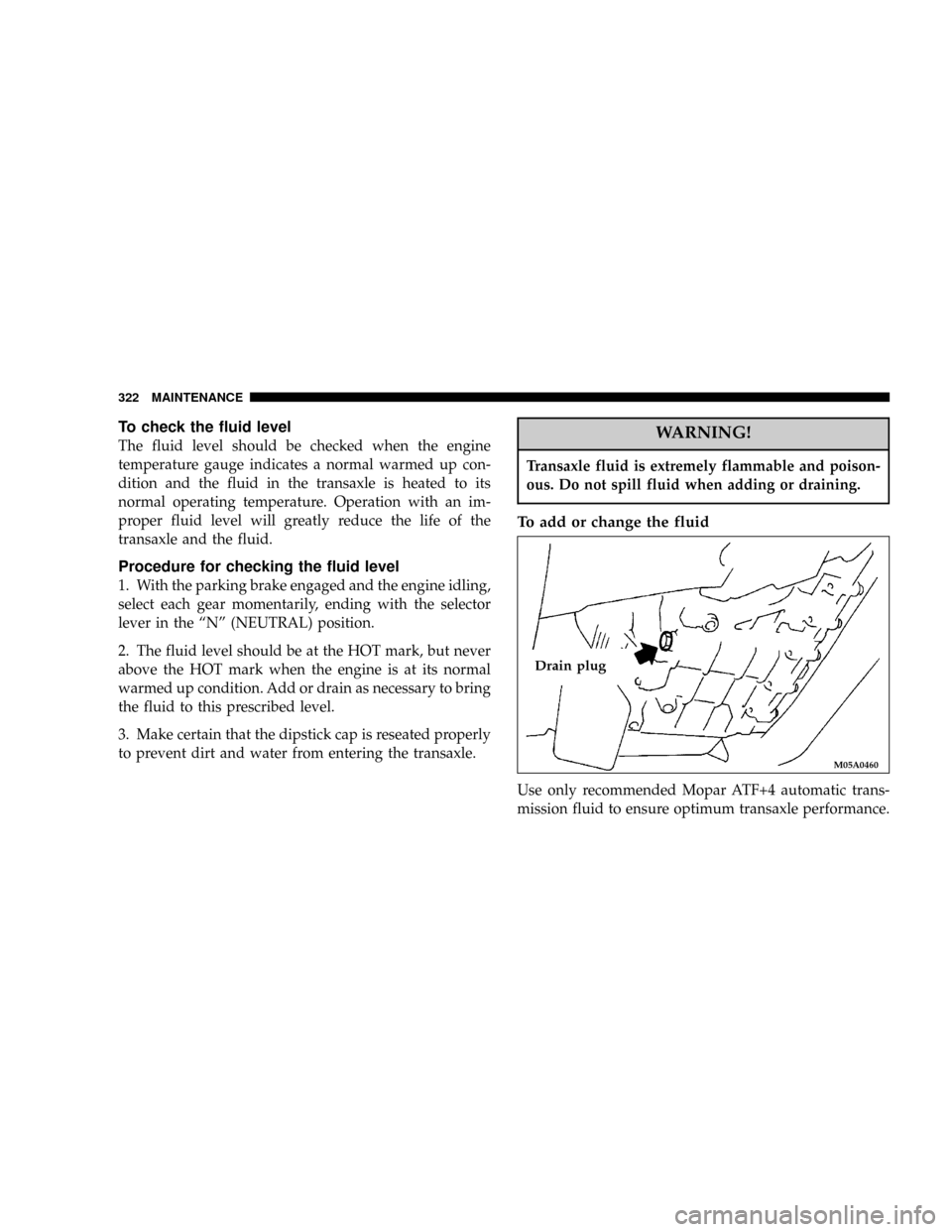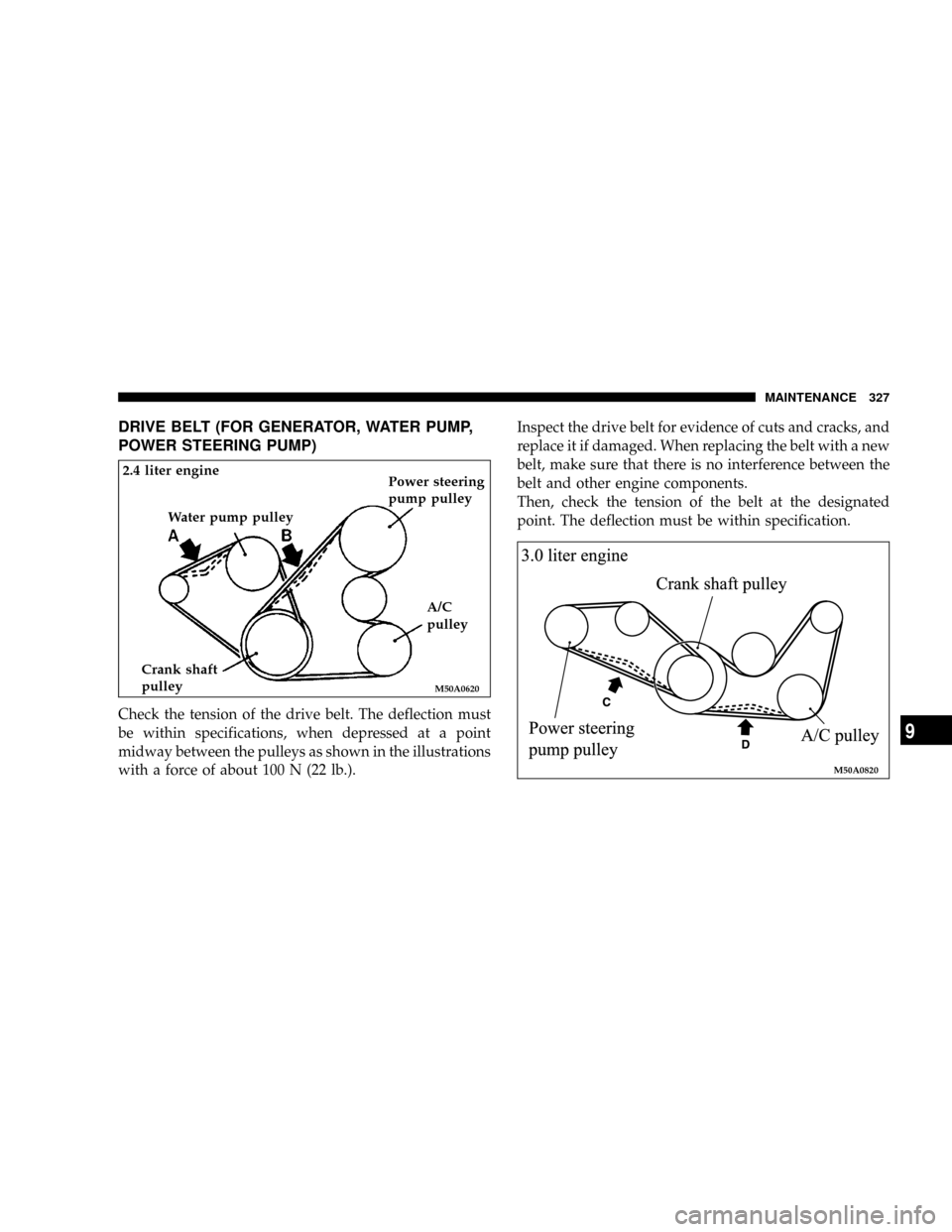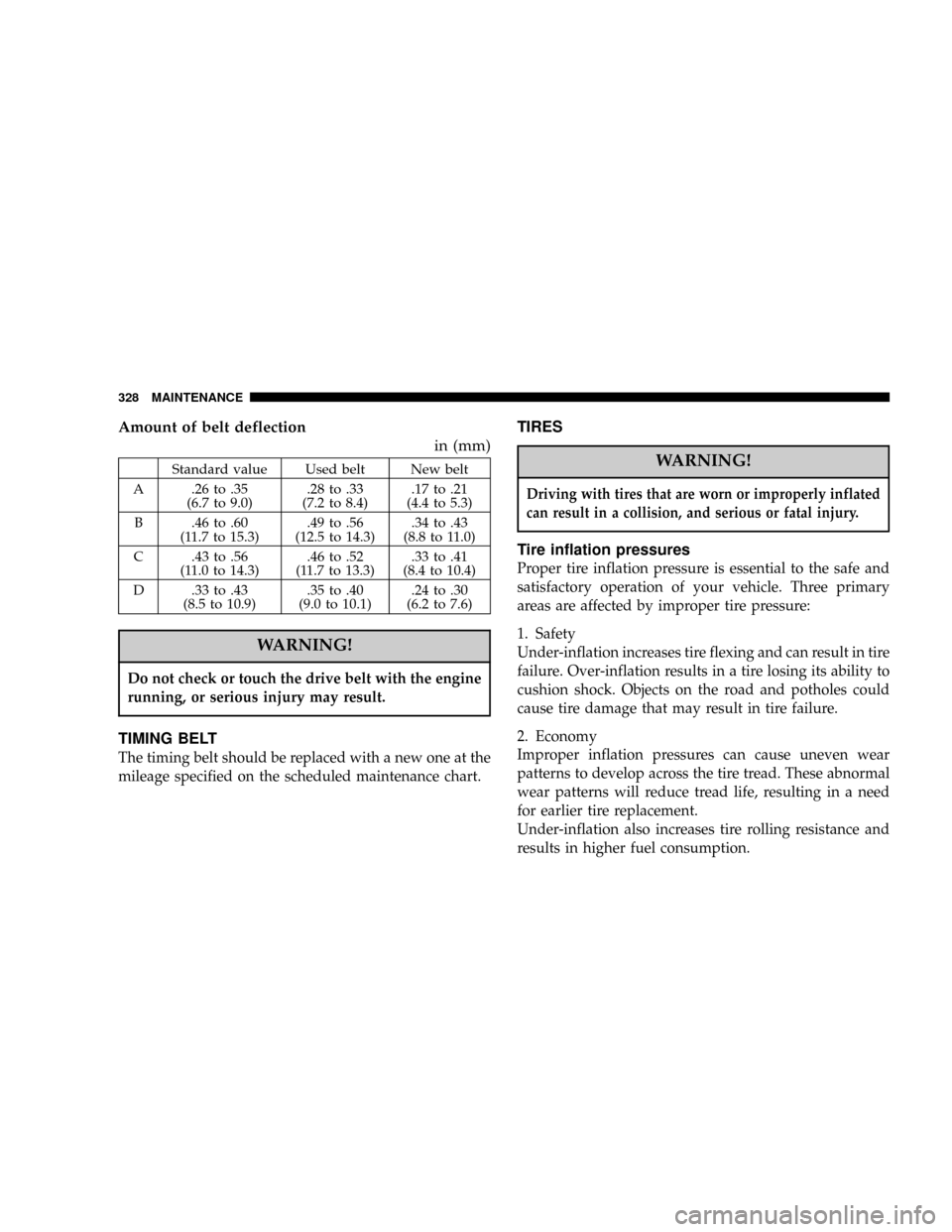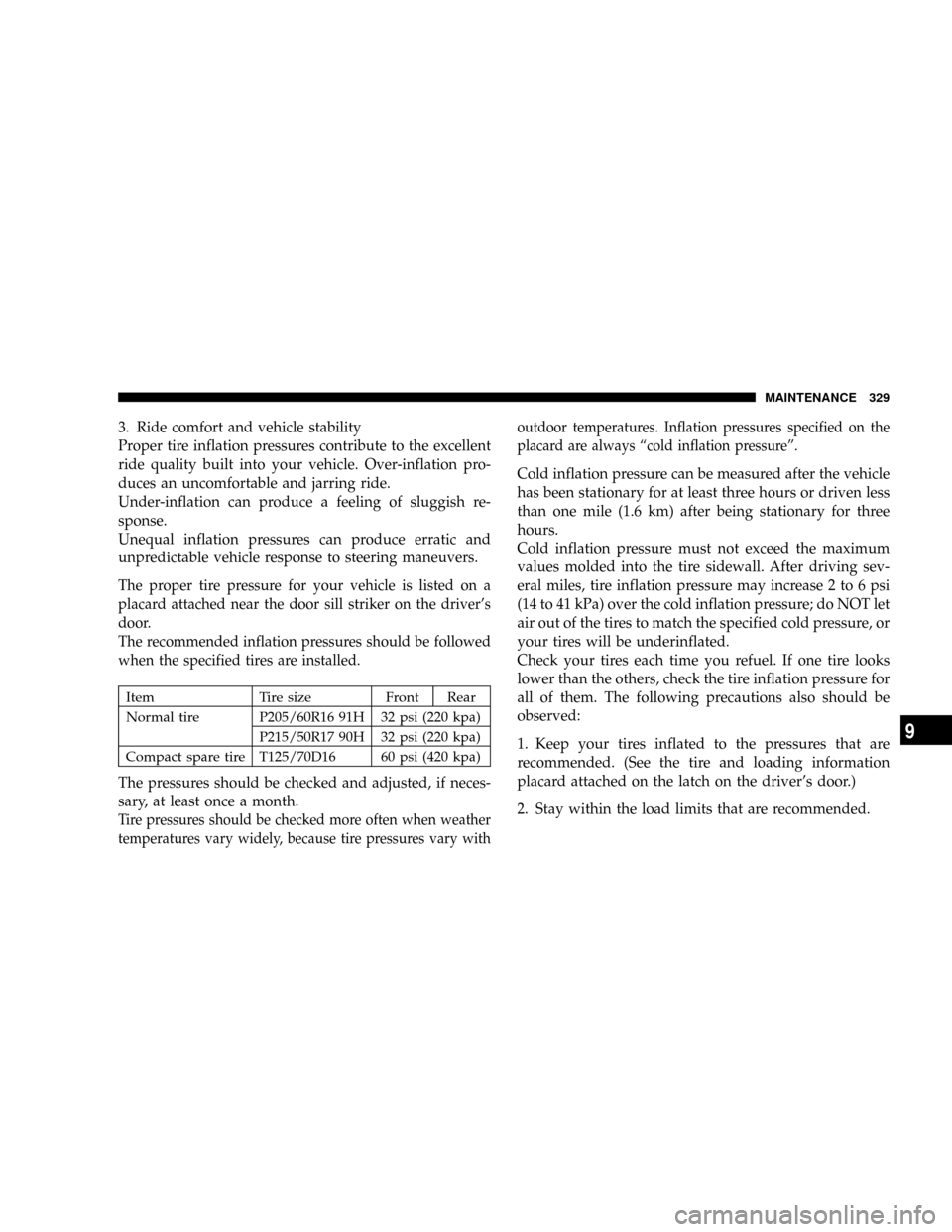CHRYSLER SEBRING COUPE 2004 2.G Owners Manual
Manufacturer: CHRYSLER, Model Year: 2004, Model line: SEBRING COUPE, Model: CHRYSLER SEBRING COUPE 2004 2.GPages: 382, PDF Size: 2.23 MB
Page 321 of 382

NOTE
1. Check each battery terminal for corrosion. If necessary,
neutralize corrosion by washing with a solution of bak-
ing soda and water. Apply grease to posts and clamps
after cleaning or tightening.
2. Before cleaning the battery, tighten all filler port caps
to prevent foreign matter from entering the battery.
3. Check to see if the battery is securely installed and
cannot be moved. Also check each terminal for tightness.
4. When the vehicle is to be left unused for a long period
of time, remove the battery and store it in a place where
the battery fluid will not freeze. The battery should be
stored only in a fully charged condition.
AUTOMATIC TRANSAXLE
The automatic transaxle should be maintained and ser-
viced by an authorized dealer to obtain the best perfor-
mance and maximize life. It is important that the trans-
axle fluid be maintained at the level prescribed.
M05A0530
Good
MAINTENANCE 321
9
Page 322 of 382

To check the fluid level
The fluid level should be checked when the engine
temperature gauge indicates a normal warmed up con-
dition and the fluid in the transaxle is heated to its
normal operating temperature. Operation with an im-
proper fluid level will greatly reduce the life of the
transaxle and the fluid.
Procedure for checking the fluid level
1. With the parking brake engaged and the engine idling,
select each gear momentarily, ending with the selector
lever in the ªNº (NEUTRAL) position.
2. The fluid level should be at the HOT mark, but never
above the HOT mark when the engine is at its normal
warmed up condition. Add or drain as necessary to bring
the fluid to this prescribed level.
3. Make certain that the dipstick cap is reseated properly
to prevent dirt and water from entering the transaxle.
WARNING!
Transaxle fluid is extremely flammable and poison-
ous. Do not spill fluid when adding or draining.
To add or change the fluid
Use only recommended Mopar ATF+4 automatic trans-
mission fluid to ensure optimum transaxle performance.
M05A0460
Drain plug
322 MAINTENANCE
Page 323 of 382

Special additives
DaimlerChrysler does not recommend the addition of
any fluid additives to the transaxle.
MANUAL TRANSAXLE
Add oil to maintain the proper level. Refill or change oil
according to the scheduled maintenance table.
Lubricant Gear Oil Classification GL-4
Viscosity range SAE75W-90 or 75W-85W
DISC BRAKE PADS, REAR DRUM BRAKE
LININGS AND REAR WHEEL CYLINDERS
Proper brakes are essential to safe operation of your
vehicle. Check brake pads and rear brake linings for
wear, and check rear wheel cylinders for leakage.
For proper braking performance, replace brake pads with
original equipment type pads.
BRAKE HOSES
Brake hoses and tubing should be checked for:
1. Severe surface cracking, scuffing or worn spots. If the
casing of the hose is exposed by cracks or abrasions in therubber hose cover, the hose should be replaced. Deterio-
ration of the hose could cause brake failure.
2. Faulty installation may cause twisting, or wheel, tire
or chassis interference.
BALL JOINT, STEERING LINKAGE SEAL AND
DRIVE SHAFT BOOTS
Check the following parts for damage and grease leak-
age:
1. Ball joint boots of the front suspension and steering
linkage
2. Bellows on both ends of the drive shaft
SUPPLEMENTAL RESTRAINT SYSTEM (SRS)
The entire SRS system must be inspected by an autho-
rized dealer 10 years after the vehicle manufacture date
shown on the certification label. [See ªSRS servicingº on
page 98.]
MAINTENANCE 323
9
Page 324 of 382

DOOR HINGES, REAR HATCH HINGES, HOOD
LOCK RELEASE MECHANISM AND SAFETY
CATCH
The door hinges, trunk hinges, hood lock release mecha-
nism and hood safety catch should be inspected, cleaned,
and lubricated as required to maintain ease of operation
and to provide protection against rust and wear. Apply
engine oil to door hinges, hood hinges, and trunk hinges.
Apply Multipurpose Grease NLGI Grade 2 sparingly to
all sliding contact areas of the hood latch and release
lever. Work lubricant into the hood lock mechanism until
all frictional surfaces are covered.
Also, apply a film of the same lubricant to the pivot
contact areas of the safety catch.
EXHAUST SYSTEM
WARNING!
Carbon monoxide gas found in the vehicle's exhaust
is poisonous. Inhalation of exhaust fumes can cause
unconsciousness or death.
The best protection against carbon monoxide entry into
the vehicle interior is a properly maintained engine
exhaust system.
Whenever a change is noticed in the sound of the exhaust
system; when exhaust fumes can be detected inside the
vehicle; or when the underside or rear of the vehicle is
damaged, have a competent technician inspect the com-
plete exhaust system and adjacent body areas for broken,
damaged, deteriorated, or mispositioned parts.
In addition inspect the exhaust system each time the
vehicle is raised for lubrication or oil change. Replace as
required.
Open seams or loose connections could permit danger-
ous exhaust fumes to seep into the trunk and passenger
compartments.
Do this service when performing underbody service.
Check for any of the following conditions:
1. Check for holes or exhaust gas leakage caused by
corrosion or damage.
2. Check the joints and connections for looseness or
exhaust gas leakage.
3. Check the rubber hangers and brackets for damage.
324 MAINTENANCE
Page 325 of 382

WINDSHIELD WIPER BLADES
Check the wiper blades occasionally. Periodic cleaning of
the wiper blades is suggested to remove the accumula-
tion of salt and road film. The wiper blade arms and glass
areas should be cleaned with a sponge or cloth and a
mild detergent or non-abrasive cleaner.
If the blades continue to streak or smear, they should be
replaced.
NOTE: Do not operate wipers for long periods on dry
glass; this accelerates deterioration of the rubber and
could scratch the glass.
Windshield washers
The windshield washer reservoir is in the engine com-
partment. Check the fluid level at regular intervals and
replenish the fluid if necessary.
NOTE: When freezing weather is anticipated flush out
the water in the reservoir by operating the pump. Fill the
reservoir with windshield antifreeze (not radiator anti-
freeze) and operate the system for a few seconds to flush
out any residual water.
M31A0730
MAINTENANCE 325
9
Page 326 of 382

PARKING BRAKE
Check the parking brake lever travel occasionally. To
check, pull the lever slowly and count the number of
clicks of the ratchet.
For vehicles with rear drum brakes:
You should feel the parking brake take hold between 5 to
7 clicks.For vehicles with rear disc brakes:
You should feel the parking brake take hold between 3 to
5 clicks. Also check to see if the lever is properly engaged
with the ratchet, when pulled.
I27A0100
326 MAINTENANCE
Page 327 of 382

DRIVE BELT (FOR GENERATOR, WATER PUMP,
POWER STEERING PUMP)
Check the tension of the drive belt. The deflection must
be within specifications, when depressed at a point
midway between the pulleys as shown in the illustrations
with a force of about 100 N (22 lb.).Inspect the drive belt for evidence of cuts and cracks, and
replace it if damaged. When replacing the belt with a new
belt, make sure that there is no interference between the
belt and other engine components.
Then, check the tension of the belt at the designated
point. The deflection must be within specification.
M50A0620
Water pump pulley
Crank shaft
pulleyPower steering
pump pulley
A/C
pulley 2.4 liter engine
M50A0820
MAINTENANCE 327
9
Page 328 of 382

Amount of belt deflection
in (mm)
Standard value Used belt New belt
A .26 to .35
(6.7 to 9.0).28 to .33
(7.2 to 8.4).17 to .21
(4.4 to 5.3)
B .46 to .60
(11.7 to 15.3).49 to .56
(12.5 to 14.3).34 to .43
(8.8 to 11.0)
C .43 to .56
(11.0 to 14.3).46 to .52
(11.7 to 13.3).33 to .41
(8.4 to 10.4)
D .33 to .43
(8.5 to 10.9).35 to .40
(9.0 to 10.1).24 to .30
(6.2 to 7.6)
WARNING!
Do not check or touch the drive belt with the engine
running, or serious injury may result.
TIMING BELT
The timing belt should be replaced with a new one at the
mileage specified on the scheduled maintenance chart.
TIRES
WARNING!
Driving with tires that are worn or improperly inflated
can result in a collision, and serious or fatal injury.
Tire inflation pressures
Proper tire inflation pressure is essential to the safe and
satisfactory operation of your vehicle. Three primary
areas are affected by improper tire pressure:
1. Safety
Under-inflation increases tire flexing and can result in tire
failure. Over-inflation results in a tire losing its ability to
cushion shock. Objects on the road and potholes could
cause tire damage that may result in tire failure.
2. Economy
Improper inflation pressures can cause uneven wear
patterns to develop across the tire tread. These abnormal
wear patterns will reduce tread life, resulting in a need
for earlier tire replacement.
Under-inflation also increases tire rolling resistance and
results in higher fuel consumption.
328 MAINTENANCE
Page 329 of 382

3. Ride comfort and vehicle stability
Proper tire inflation pressures contribute to the excellent
ride quality built into your vehicle. Over-inflation pro-
duces an uncomfortable and jarring ride.
Under-inflation can produce a feeling of sluggish re-
sponse.
Unequal inflation pressures can produce erratic and
unpredictable vehicle response to steering maneuvers.
The proper tire pressure for your vehicle is listed on a
placard attached near the door sill striker on the driver's
door.
The recommended inflation pressures should be followed
when the specified tires are installed.
Item Tire size Front Rear
Normal tire P205/60R16 91H 32 psi (220 kpa)
P215/50R17 90H 32 psi (220 kpa)
Compact spare tire T125/70D16 60 psi (420 kpa)
The pressures should be checked and adjusted, if neces-
sary, at least once a month.
Tire pressures should be checked more often when weather
temperatures vary widely, because tire pressures vary withoutdoor temperatures. Inflation pressures specified on the
placard are always ªcold inflation pressureº.
Cold inflation pressure can be measured after the vehicle
has been stationary for at least three hours or driven less
than one mile (1.6 km) after being stationary for three
hours.
Cold inflation pressure must not exceed the maximum
values molded into the tire sidewall. After driving sev-
eral miles, tire inflation pressure may increase 2 to 6 psi
(14 to 41 kPa) over the cold inflation pressure; do NOT let
air out of the tires to match the specified cold pressure, or
your tires will be underinflated.
Check your tires each time you refuel. If one tire looks
lower than the others, check the tire inflation pressure for
all of them. The following precautions also should be
observed:
1. Keep your tires inflated to the pressures that are
recommended. (See the tire and loading information
placard attached on the latch on the driver's door.)
2. Stay within the load limits that are recommended.
MAINTENANCE 329
9
Page 330 of 382

3. Make sure that the weight of your vehicle load is
evenly distributed.
4. Drive at safe speeds.
5. After the tire inflation pressure has been adjusted,
check the tires for damage and air leaks. Be sure to
replace the rubber caps on the valve stems.
Radial ply tires
Radial ply tires provide improved tread life, road hazard
resistance and smoother high speed ride. The radial ply
factory-installed tires on this vehicle are of belted con-
struction and are selected to complement the ride and
handling characteristics of your vehicle.
Radial ply tires have the same load carrying capacity as
bias or bias-belted tires of the same letter size, and use the
same recommended inflation pressures.
Mixing of radial ply tires with bias or bias-belted tires is
not recommended. Combining radial ply and bias or
bias-belted tires on one vehicle will negatively affect
vehicle handling. It is recommended that radial ply tires
should always be used as a set of four.As longer wearing tires can be more susceptible to
irregular tread wear, it is very important to follow the tire
rotation interval shown in the section ªTire rotationº to
achieve full tread life potential in these tires.
Cuts and punctures in radial ply tires are repairable only
in the tread area, because of sidewall flexing. Consult
your tire dealer for radial ply tire repairs.
Tire pressure for sustained high-speed driving
For sustained high-speed driving, increase inflation pres-
sure 4 psi (28 kPa) above the recommended pressure but
do not exceed the maximum cold inflation pressure
molded into the tire sidewall.
Oversize tires
The use of tire sizes other than those listed may cause
interference with vehicle components under extremes of
suspension and steering travel, and may result in tire and
vehicle damage.
330 MAINTENANCE